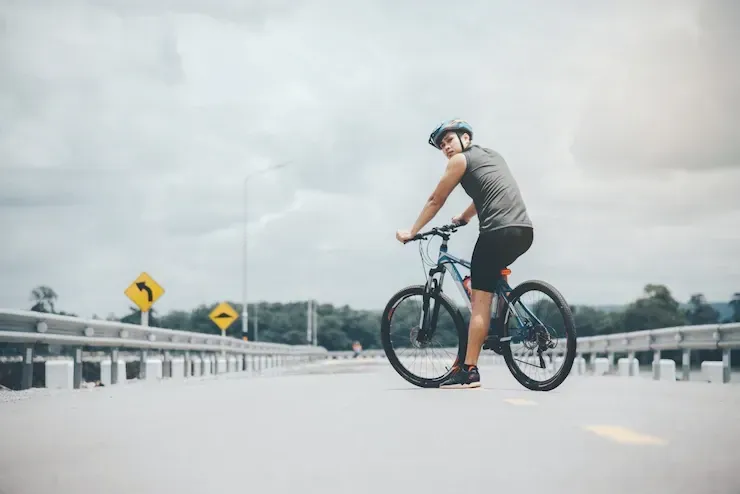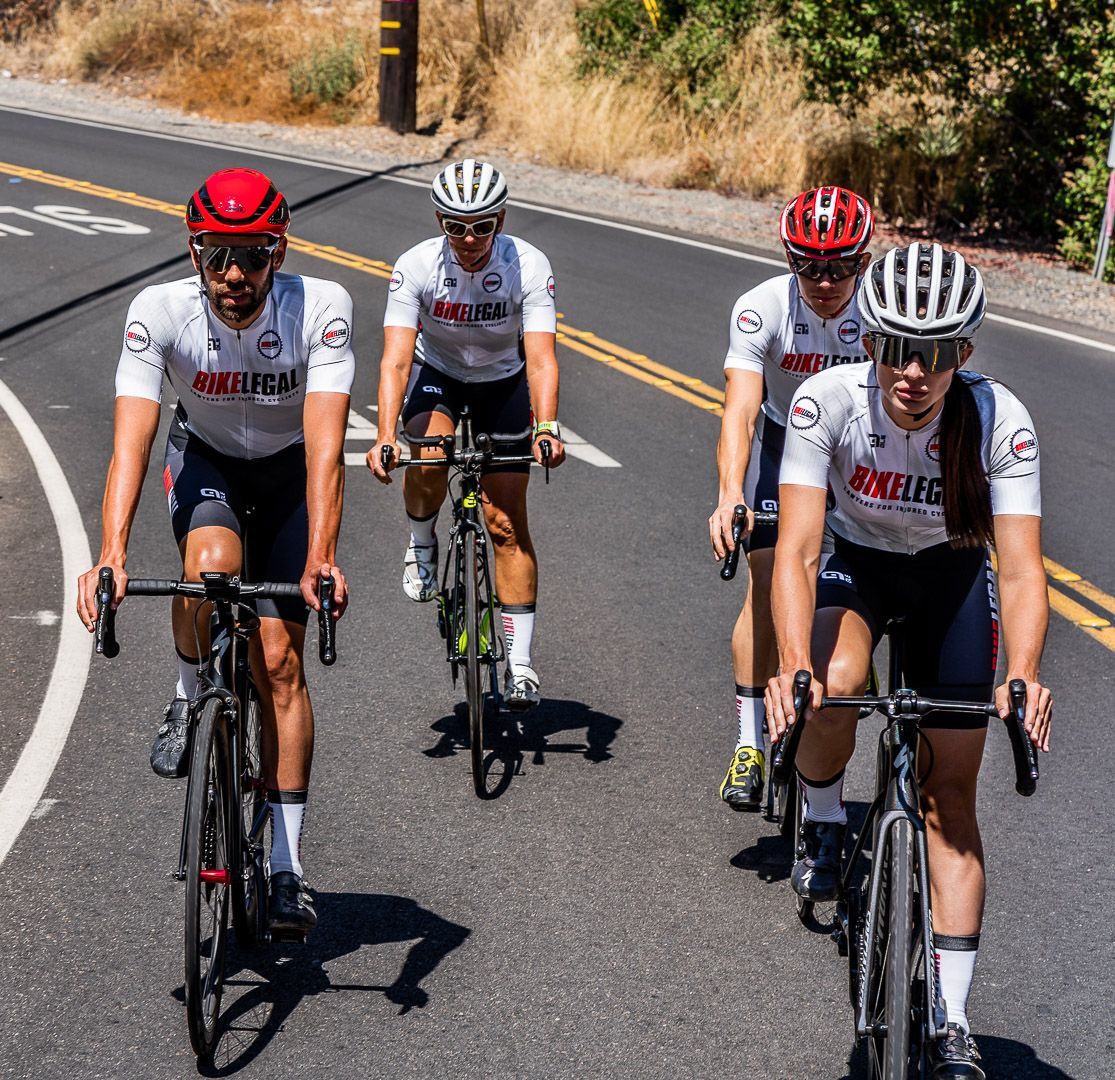Cycling Laws in the United States
Follow us on
social media!
Bike Laws: Is it legal to ride a bicycle on the sidewalk in US?

Although an old invention, it was only 100 years ago that cycling became popular among the working class in the United States. With an enormous surge of cyclists all over the cities, the situation became chaotic, with increasing conflicts between other road users and cyclists. Furthermore, there was no clear indication if existing traffic laws applied to bicycle riders.
After decades of legal battles, today, we have statewide laws that protect cyclists and help you prevent injuries and deaths occurring from bicycle crashes. And if you still somehow get caught up in a bicycle accident, some laws protect your rights as a cyclist.
In this blog, we will navigate federal and state-specific cycling laws, examine traffic regulations for cyclists, and delve into safety equipment requirements and guidelines that govern cyclists on the roads, trails, and pathways throughout the country.
Common Traffic Laws for Cyclists

Today's traffic laws relate to the Uniform Vehicle Code (UVC) of 1926. However, at that time, bicycles were not considered vehicles, but UVC changed its definition of vehicles in 1975 to include bicycles. Since then, most states have required bicyclists to follow the same laws as other motorists.
Some general vehicle codes that all 50 states require cyclists to follow are:
1. All Road Users Have the Same Rights
Everyone on the road has the right to use the entire width of their lane. You cannot drive in the middle of the street or straddle the centerline. You cannot park in the roadway or block the road with your vehicle.
If you want to use someone else's space, yield to them. This means that you must slow down or stop to let them pass. You should also use your turn signals to indicate your intentions.
2. Ride on the Right
In the United States, everyone must drive on the right-hand side of the roadway. This includes bicycles. This is because it is the safest way to travel. When everyone goes in the same direction on the road, it is easier to see each other and avoid accidents.
3. Yielding To Crossing Traffic
When approaching an intersection, cyclists must yield to all crossing traffic, including cars, trucks, and buses. This means that you must slow down or stop to let other vehicles pass. You should also use your hand signals to indicate your intentions. Moreover, If you want to change lanes, yield to the traffic already in the lane you're changing into.
4. Speed Positioning
The slowest vehicles on the road should be the furthest to the right. This is because it is the safest and most efficient way to travel. When slower vehicles stay to the right, faster vehicles can pass them on to the left. This helps to keep traffic flowing smoothly and reduces the risk of accidents.
5. Lane Positioning
Bicycles are allowed to share lanes with other drivers on the road. If a lane is wide enough (around 14 feet), cyclists should ride about three feet to the right of traffic. However, if the street is not wide enough to share, cyclists should "take the lane" by riding in the middle to indicate that the lane is too narrow for vehicles to pass safely.
6. Intersection Positioning
In situations where a lane accommodates traffic from multiple directions, opting for the rightmost lane that corresponds to your intended travel direction is recommended. Choosing the appropriate lane ensures better alignment with traffic flow and promotes smoother navigation.
Statewide Comparison of Bicycle Laws
All 50 states of the United States have their own set of bicycle laws, and it's essential to understand these laws to steer clear of any violation.
Below are 14 bicycle laws that have been compared across different states of the United States. It's always best to check your state-specific bicycle laws to avoid infringement.
1. Treatment of Bicycles as ‘Vehicles'
In all 50 states, bicyclists are considered vehicles or have the same rights and responsibilities as motorists.
However, whether your state considers bicycle vehicles and gives bicyclists the same rights and responsibilities as motorists can matter.
Check
here
to see what the law in your state says about bicycles.
2. Safe Passing Laws
Safe passing laws ensure vehicles pass each other while maintaining a safe distance. In most states, the defined safe space is at least three feet. All states have some form of safe passing law.
In 45 states and the District of Columbia, safe passing laws explicitly include provisions for bicyclists. Safe passing rules in the remaining five states generally apply to all road users without mentioning bicyclists.
Find out
what the safe passing law is in your state.
3. Vulnerable Road User Laws
Vulnerable Road User (VRU) laws are designed to provide more protection for people not in cars, such as bicyclists/pedestrians. These laws usually involve stricter penalties for breaking existing laws if it affects a specific group of road users.
Most VRU laws increase fines or civil liability when a vulnerable road user, like a bicyclist, is injured or killed due to negligence or a traffic violation.
Click here to see what the VRU rules in your state are.
4. Where to Ride Rules
Cycling rules and regulations differ across states, specifying where to ride your bike. In some states, cycling is limited to designated bike paths or lanes, while others allow cycling on public roads.
In certain situations, if no designated bike lane is available or the lane is in poor condition or inaccessible, certain locations may allow cyclists to ride on the sidewalk instead of a dedicated lane.
Check
here
to see where you can ride in your state.
5. Helmet Laws
The rules regarding wearing bicycle helmets in the United States differ based on jurisdiction and the cyclist's age. For instance, 21 states and the District of Columbia have laws that mandate helmet usage for children statewide. On the other hand, 29 states have no statewide helmet laws; 13 states do not have any such rules at any lower-level jurisdiction.
Check
here what rule applies in your state.
6. Other Safety Equipment Laws
Bicycles are required to have either front and rear brakes or just rear brakes. However, bikes intended for sidewalk use cannot have hand brakes alone. If a sidewalk bicycle has a seat height of 22 inches or more when adjusted to the lowest position, it must have a foot brake. On the other hand, if a sidewalk bicycle has a seat height of less than 22 inches, it is not required to have any brakes as long as it lacks a freewheeling feature. Additionally, it must have a permanent label stating "No brakes."
7. Dooring Laws
Dooring laws require individuals inside a car to open their doors cautiously, considering the flow of other traffic around. Typically, these laws state that a person opening a vehicle door must make sure it is safe to do so, that it won't disrupt the movement of traffic, and that the door remains open for the shortest possible time.
Many bicyclists sustain injuries when cars unexpectedly open the car door in the middle of the road. These regulations ensure cyclist safety on the road.
Check your state regulation on dooring here.
8. Sidewalk Riding Laws
Sidewalk riding laws dictate what bicyclists are allowed and required to do when they ride bicycles on sidewalks. The rules can be complex because bicycles fall into different categories under traffic laws in most states.
Viewing bicycles as vehicles grants them the same rights and responsibilities as other vehicles. However, sometimes, bicycles are treated like pedestrians and have to follow pedestrian rules.
To understand what your state says about bicycle riding on sidewalks, click here.
9. Mandatory Use of Bicycle Facilities Laws
Mandatory Use of Bicycle Facilities laws require bicyclists to utilize the facilities specifically designed for use. For example, bicyclists should use separated paths, marked bike lanes, or the shoulder of the road instead of the roadways intended for automobiles.
In 16 states, laws require or allow local authorities to mandate using bike lanes, bike paths, or shoulders when available.
See
here
if your state requires you to follow bicycle facilities laws.
10. Distracted Driving Laws
Distracted driving is the leading cause of accidents in the United States. And cyclists are the most susceptible to being victims of this reckless behavior.
Lawmakers created distracted driving laws to prevent distractions like texting and to mandate the use of hands-free devices when using mobile devices while driving.
Check here to see what the distracted driving law in your state is. And, if you've been a victim of distracted driving, contact a bicycle accident lawyer today to see if you're eligible for a claim.
11. Idaho Stop Laws
An "Idaho stop" law means that when bicyclists encounter a stop sign, they don't have to come to a complete stop like cars do at stop signs. Instead, they must slow down, stop for safety, and yield to any approaching vehicles or pedestrians before crossing the intersection controlled by the stop sign.
Red light exceptions, known as "dead red" laws, have different variations. These laws allow certain vehicles to go through a red light after stopping for a specific amount of time.
Does your state implement the Idaho Stop Law? Find out here.
12. Cycling Under Influence Laws
Laws regarding cycling under the influence (CUI) are not very common. These laws establish specific penalties for bicyclists caught riding while under the influence of drugs or alcohol.
To determine if CUI laws apply to bicyclists, examining how the state code defines vehicles and bicycles is crucial. In certain states, CUI laws may either explicitly exclude vehicles powered solely by human effort or have a modified definition primarily focusing on motor vehicles.
There are 18 states with legal precedents addressing applying CUI laws to bicyclists. Find out here if your state enforces these laws.
13. Public Transportation
Many states permit bringing bikes onto buses and trains for transportation convenience. However, specific guidelines and requirements are in place to ensure the safe handling and storage of bicycles during the journey.
These guidelines often fall under the broader laws governing public transportation usage. For instance, in Tempe, AZ, USA, failure to adhere to the designated bicycle storage rules on the light rail can be treated as fare evasion, as it implies traveling without paying the appropriate fare.
14. Night-Time Bicycle Riding Laws
Some states have specific regulations for bicycle lighting and audible signals to enhance safety during nighttime rides. These regulations go beyond reflectors and include a forward-facing white light visible up to 600 feet, a rear-facing red light with the same visibility range, and an audible signal that can be heard from at least 100 feet away.
These requirements aim to improve visibility and communication for cyclists, reducing the risk of accidents during low-light conditions.
Importance of Following The Biking Laws
Following biking laws in the United States is of utmost importance for several compelling reasons.
- It helps ensure the safety of both cyclists and others sharing the roadways.
- Promotes orderly and predictable behavior, reducing the risk of collisions and accidents.
- Maintaining a harmonious coexistence between road users like pedestrians, motorists, etc.
- It can prevent legal repercussions and financial consequences.
- Build a favorable perception of biking as a safe and viable means of transportation.
- Supports the overall advocacy for cycling infrastructure and safety.
Know When to Contact a Bicycle Accident Lawyer
Negligence of motorists can cause even the most cautious and law-abiding cyclists to be involved in accidents. When these incidents occur, having a dedicated legal team on your side is crucial. At Bike Legal, we specialize in bicycle accident cases, fighting for the rights of injured cyclists. We navigate the complexities of bicycle injury claims and fight for the compensation you deserve.
Call us at 877-245-3534 for a free consultation today. Our dedicated team is ready to assist you throughout the process, offering the expertise and representation necessary to seek justice and aid in your recovery from the bicycle accident. We understand the unique challenges cyclists face and the complexities of these cases, and we are here to provide the support and guidance you need.
FAQs
Are Bikes Allowed on the Sidewalk?
The permissibility of bikes on sidewalks depends on how your state defines bicycles. Some states define bikes as vehicles, while others enforce the same rules as pedestrians. It's best to check state regulations to know if you can ride a bicycle on sidewalks.
Do You Need a License to Ride a Bicycle?
Generally, there are no federal regulations in the US regarding riding a man-powered bike. However, there may be some exceptions if you have a motorized or electric bike.

